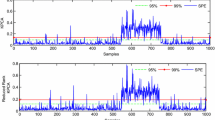Abstract
This paper suggests an extension of the PCMD index proposed for sensor fault diagnosis in linear systems to the nonlinear case. The proposed index is entitled KPCMD, and it is based on Mahalanobis distance and moving window kernel principal component analysis (MWKPCA) technique. The principle of this index is to detect dissimilarity between a reference KPCA model that represents normal operation of the system and a current KPCA model that represents current system behavior. The proposed KPCMD index compute Mahalanobis distance between principal components corresponding to the reference KPCA model and those corresponding to the current KPCA model which are obtained online using MWKPCA. The proposed KPCMD indices have been applied successfully for monitoring of numerical example as well a continuous stirred tank reactor (CSTR).
Similar content being viewed by others
References
Qin SJ (2003) Statistical process monitoring: basics and beyond. J Chemom 17(8):480–502
McAvoy TJ (2002) Intelligent "control" applications in the process industries. Annu Rev Control 26(1):75–86
Frank PM (1990) Fault diagnosis in dynamic systems using analytical and knowledge-based redundancy—a survey and some new results. Automatica 26(3):459–474
Tharraut Y, Mourot G, Ragot J, Maquin D (2008) Fault detection and isolation with robust principal component analysis. Int J Appl Math Comput Sci 18(4):429–442
Jaffel I, Taouali O, Elaissi I, Messaoud H (2014) A new online fault detection method based on PCA technique. IMAJ Math Control Inf 31(4):487–499
Li G, Qin SJ, Zhou D (2010) Geometric properties of partial least squares for process monitoring. Automatica 46(1):204–210
Zhang Y, Ma C (2011) Fault diagnosis of nonlinear processes using multiscale KPCA and multiscale KPLS. ChemEngSci 66:66–72
Lee J, Yoo C, Lee I (2004a) Statistical process monitoring with independent component analysis. J Process Control 14(5):467–485
Zhao C, Wang F, Mao Z, Lu N, Jia M (2008) Adaptive monitoring based on independent component analysis for multiphase batch processes with limited modeling data. Am ChemSoc 47:3104–3113
Dunia R, Qin J, Edgar TF, McAvoy TJ 1996 Identification of faulty sensors using principal component analysis, AIChE Journal
Harkat MF, Mourot G, Ragot J 2001 “Sensor failure detection and Isolation of air quality monitoring network”. 4th International Conference on Acoustical and Vibratory Surveillance Methods and Diagnostic Techniques, Compiègne, France
Wang X, Kruger U, Irwin GW (2005) Process monitoring approach using fast moving window PCA. Ind Eng Chem Res 44:5691–5702
Jeng JC (2010) Adaptive process monitoring using efficient recursive PCA and moving window PCA algorithms. J Taiwan Inst Chem Eng 41:475–481
Krzanowski W (1979) Between-groups comparison of principal components. J Am Stat Assoc 74:703–707
Jaffel I, Taouali O, Harkat MF, Messaoud H (2015) Online process monitoring using a new PCMD index. Int J Adv Manuf Technol 80(5):947–957
Schölkopf B, Smola A, Muller K-R (2012) Nonlinear component analysis as kernel eigenvalue problem. Neural Comput 10:1299–1319
Lee JM, Yoo C, Choi SK, Vanrolleghemb PA, Lee I (2004b) Nonlinear process monitoring using kernel principal component analysis. ChemEngSci 59:223–234
Taouali O, Elaissi I, Messaoud H (2012) Online identification of non-linear system using reduced kernel principal component analysis. Neural Comput 21:161–169
Fazai R, Taouali O, Harkat MF, Bouguila NA 2016 new fault detection method for nonlinear process monitoring. Int J Adv Manuf Technol
Aronszajn N (1950) Theory of reproducing kernels. Trans Am Math Soc 68(3):337–404
Mika S, Schölkopf B, Smola AJ, Muller, KJ; Scholz M.; Ratsh G, “Kernel PCA and de-nosing in feature spaces”. Proc AdV Neural Inform Process Syst. II 1999, pp. 536–542.
Liu X, Xie L, Kruger U, Littler T, Wang S (2009) Moving window kernel PCA for adaptive monitoring of nonlinear processes. ChemomIntell Lab Syst 96:132–143
Dong D, McAvoy TJ (1996) Nonlinear principal component analysis-based on principal curves and neural networks. Comput Chem Eng 20:65–78
Cho JH, Lee JM, Choi SW, Lee DW, Lee IB (2005) Fault identification for process monitoring using kernel principal component analysis. Chem Eng Sci 60:279–288
Vapnik VN (1998) Statistical learning theory. Wiley, New York
Author information
Authors and Affiliations
Corresponding author
Rights and permissions
About this article
Cite this article
Lahdhiri, H., Taouali, O., Elaissi, I. et al. A new fault detection index based on Mahalanobis distance and kernel method. Int J Adv Manuf Technol 91, 2799–2809 (2017). https://doi.org/10.1007/s00170-016-9887-3
Received:
Accepted:
Published:
Issue Date:
DOI: https://doi.org/10.1007/s00170-016-9887-3



